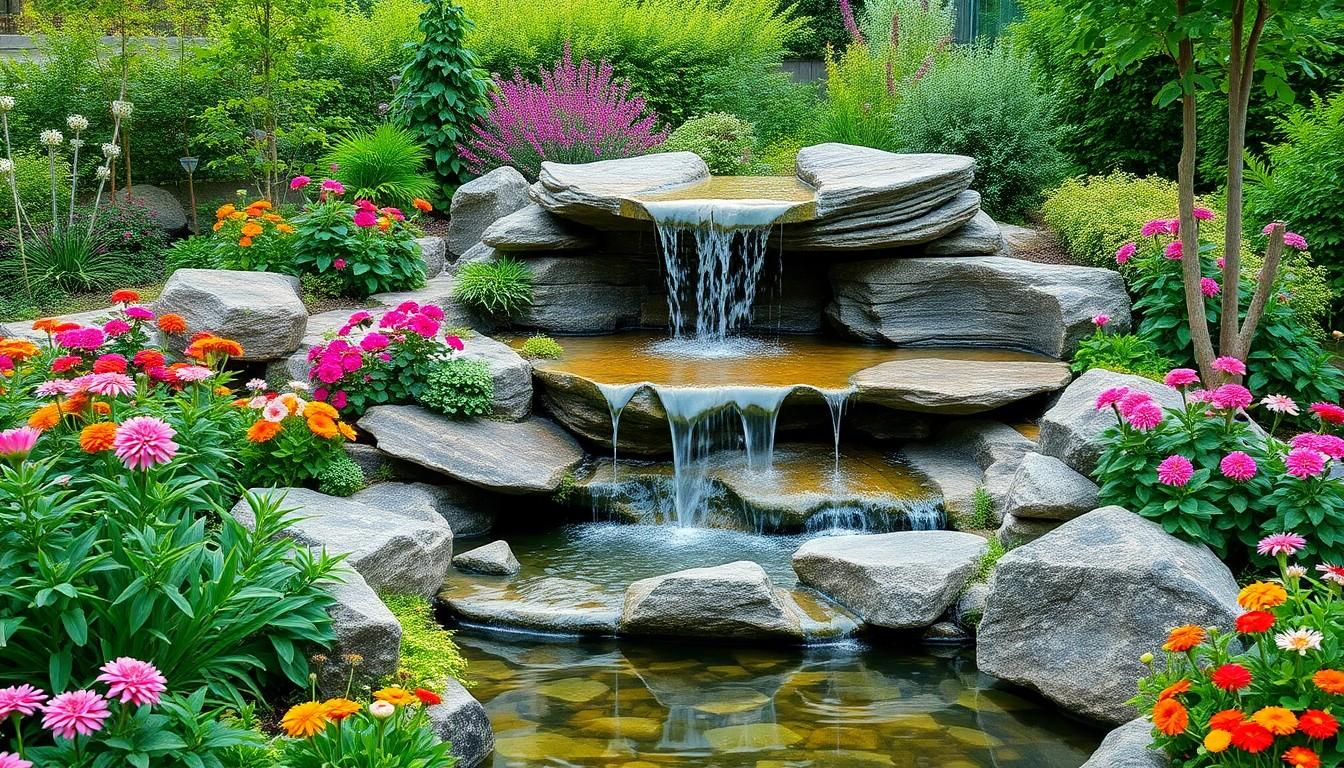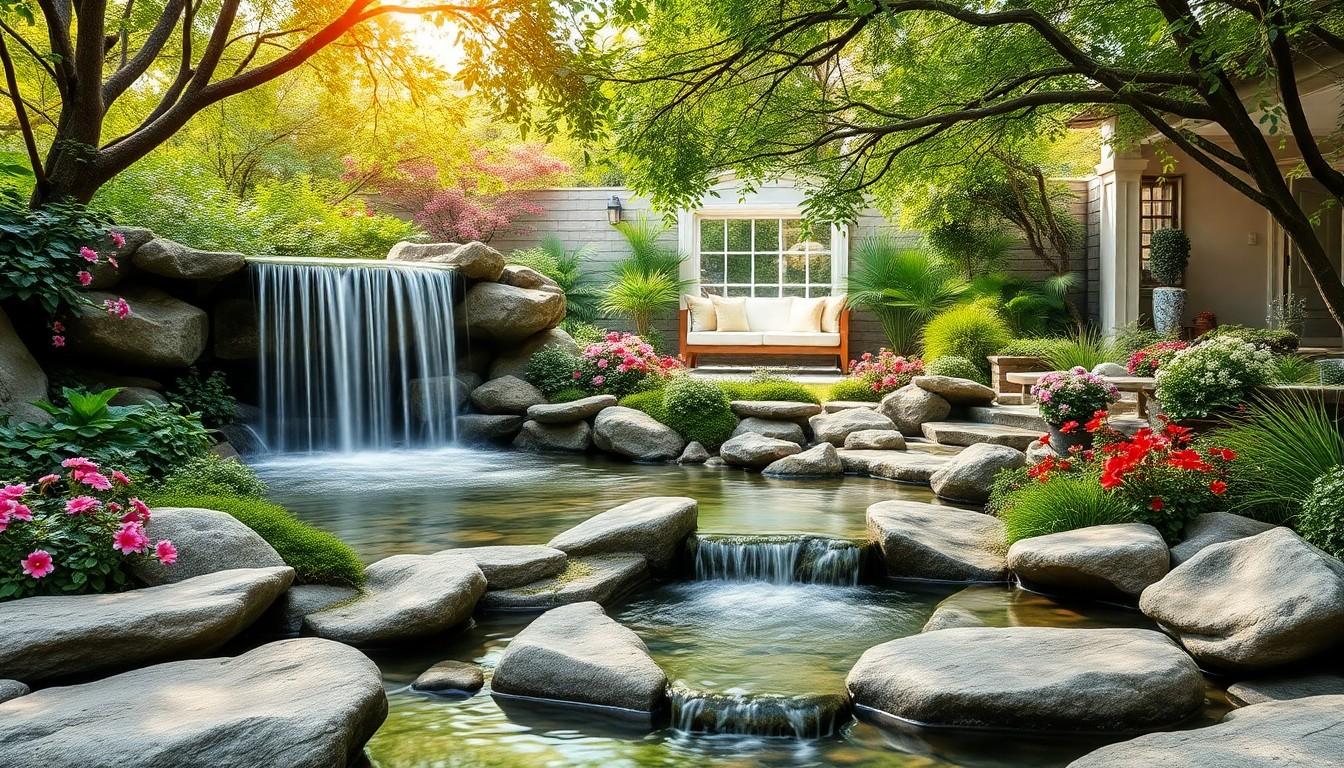Imagine stepping into your backyard and being greeted by the soothing sound of water cascading over rocks, instantly melting away the stress of the day. Garden waterfalls aren’t just a pretty sight; they transform ordinary outdoor spaces into tranquil retreats. With the right design, a waterfall can turn a simple garden into an enchanting oasis that even your neighbor’s cat will envy.
But it’s not just about aesthetics. These charming features can attract wildlife, improve air quality, and even boost your property value. Plus, who wouldn’t want to impress their guests with a natural symphony of splashes and gurgles? Dive into the world of garden waterfalls and discover how to create a serene escape right at home, where relaxation flows as freely as the water itself.
Overview Of Garden Waterfalls
Garden waterfalls serve as stunning focal points in outdoor spaces. They create a soothing ambiance that invites relaxation. Various styles influence their design, from natural rock formations to sleek modern structures. Popular materials include stone, concrete, and fiberglass, each offering unique aesthetics and durability.
Wildlife often finds refuge in these environments. Birds, butterflies, and beneficial insects are drawn to flowing water, contributing to ecosystem balance. Such features enhance not only visual appeal but also ecological benefits by promoting biodiversity.
Maintenance contributes to the longevity of garden waterfalls. Regular checks on filtration systems and water levels ensure optimal performance. Cleaning the basin and surrounding areas prevents algae and debris buildup, maintaining clarity and functionality.
Installation complexity varies depending on design and size. DIY options exist for those with skills, offering an exciting hands-on project. Professional services provide peace of mind and expertise for more intricate designs, ensuring proper installation and alignment.
The placement of a waterfall matters significantly. Situating it near seating areas can create a serene ambiance enjoyed during gatherings. Strategic positioning can also maximize sound and visual effects, enhancing the overall landscape.
Costs fluctuate based on materials, size, and features. Basic models may start at several hundred dollars, while elaborate custom installations can run into thousands. Understanding budget considerations helps in planning an enjoyable outdoor experience.
Incorporating lighting can transform the waterfall at night. LED fixtures highlight water movement, adding dramatic effect. This feature elevates the space, providing beauty after sunset and allowing year-round enjoyment.
Garden waterfalls enrich outdoor environments, offering tranquility, aesthetic appeal, and natural diversity. Exploring diverse options and designs can lead to a personalized outdoor retreat that satisfies individual tastes and preferences.
Benefits Of Garden Waterfalls

Garden waterfalls enhance outdoor spaces by offering numerous benefits. From visual allure to soothing sounds, these features create a serene environment.
Aesthetic Appeal
Visual appeal stands out as one of the primary advantages of garden waterfalls. Unique designs, whether natural rock formations or sleek modern structures, serve as stunning focal points in any yard. Various materials, such as stone and fiberglass, seamlessly integrate with landscaping themes. Colors and textures invite the eye, adding depth to flat garden spaces. Incorporating plants around the waterfall amplifies its beauty, creating a vibrant ecosystem. Guests often find themselves drawn to the enchanting sights, making gardens more inviting.
Sound and Relaxation
Soothing sounds contribute significantly to the benefits of garden waterfalls. The gentle trickle of water produces calming white noise, effectively masking unwanted background sounds. Relaxation springs from this serene soundscape, promoting stress relief and mental clarity. Spaces transform into peaceful retreats where individuals can unwind after hectic days. Additionally, the rhythmic flow of water encourages meditation and mindfulness practices. A garden waterfall nurtures emotional well-being by fostering a serene atmosphere.
Types Of Garden Waterfalls
Garden waterfalls come in various styles, catering to different preferences and landscapes. Two prominent categories include naturalistic and modern waterfalls.
Naturalistic Waterfalls
Naturalistic waterfalls blend seamlessly with their surroundings, often resembling natural water features. Stone and boulders create a rugged appearance that mimics nature, enhancing the wild aesthetic. Plants and foliage typically surround these waterfalls, fostering a sense of harmony within the garden. Flow rates vary according to design, allowing for tranquil sounds that soothe the mind. Naturalistic waterfalls often function as habitats for local wildlife, attracting birds and insects, which promote ecological benefits.
Modern Waterfalls
Modern waterfalls introduce a sleek, contemporary touch to garden spaces. Often constructed from glass, stainless steel, or concrete, these features emphasize clean lines and minimalist designs. Colorful LED lighting can enhance their visual impact, creating stunning nightscapes. Waterfall installations usually feature precise water flow, producing a steady, calming sound that enhances relaxation. Maintenance is generally straightforward, requiring less effort compared to more traditional designs. Modern waterfalls serve as striking focal points that complement contemporary landscapes.
Designing Your Garden Waterfall
Designing a garden waterfall involves careful consideration of its functionality and aesthetics. Thoughtful planning ensures a seamless integration into the landscape.
Choosing The Right Location
Selecting the ideal spot for a waterfall enhances its impact. Consider placing it near seating areas to maximize enjoyment. Proximity to trees or shrubs often creates a natural backdrop, enhancing visual appeal. Additionally, avoid areas with excessive sunlight, as this can promote algae growth. Observe the surroundings for potential views from inside the home. Lastly, ensure the area allows for proper drainage to prevent water pooling.
Materials And Construction
Choosing the right materials influences the waterfall’s overall look and durability. Natural stone offers a timeless, rustic appearance, while concrete provides versatility in design. Fiberglass stands out for its lightweight nature and ease of installation. Each option requires specific construction methods; for instance, crafting a stone waterfall may involve expertise in masonry. Consider incorporating features like LED lighting for added visual interest. Professionals often recommend thorough waterproofing to extend the waterfall’s lifespan. Prioritize sustainable materials that promote eco-friendliness and enhance the natural environment.
Maintenance Tips For Garden Waterfalls
Regular maintenance ensures the longevity and beauty of garden waterfalls. Start by checking the filtration system; clean filters every month to prevent clogs that can disrupt water flow. Inspect pumps and ensure they operate efficiently; replace them if they show signs of wear.
Algae buildup can detract from the waterfall’s visual appeal and water quality. To combat this issue, maintain proper water chemistry with regular testing and treat the water as necessary. Consider using aquatic plants that naturally filter the water and compete with algae for nutrients.
Debris accumulation often occurs from leaves and twigs, especially during autumn. Clean the waterfall and surrounding areas weekly to remove this debris and prevent blockage. Additionally, inspect the water level regularly; topping off the water may be necessary during hot weather to maintain the flow.
Seasonal care is essential. Before winter, prepare the waterfall by draining water and removing any fragile components, such as lights, to prevent damage from freezing temperatures. During spring, reassemble and check all components for functionality after winter’s weather.
Regularly assess the landscape surrounding the waterfall. Trim back overgrown plants that may obstruct views or interfere with water flow. Promoting healthy flora around the waterfall enhances its aesthetic appeal and biodiversity.
Lastly, document any changes in water quality or flow. This record helps identify issues early and ensures that the waterfall remains a serene focal point in the garden. Implementing these maintenance tips creates a thriving, beautiful waterfall that adds value to outdoor spaces.
Conclusion
Garden waterfalls offer a unique blend of beauty and tranquility that can transform any outdoor space. By choosing the right design and location, they create a serene atmosphere that invites relaxation and enhances the overall aesthetic of a yard.
With the added benefits of attracting wildlife and improving air quality, these features not only serve as stunning focal points but also contribute to a healthier environment.
Whether opting for a naturalistic or modern style, proper planning and maintenance are key to ensuring longevity and enjoyment. Embracing the soothing sounds of flowing water can turn any garden into a personal retreat, enriching both the landscape and the homeowner’s well-being.

